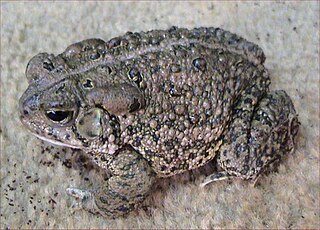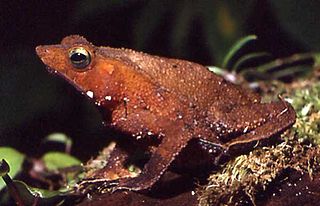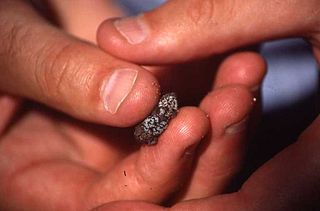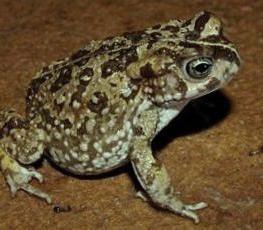See also
![]() Data related to Cranopsis at Wikispecies
Data related to Cranopsis at Wikispecies
The Latin word Cranopsis has been used to name animal genera of frogs, mollusks and branchiopods. Cranopsis (Cope 1875), was used for an anuran, and is a junior homonym of Cranopsis (Adams 1860), for a mollusk; and Cranopsis (Dall 1871), for a branchiopod. [1] Cranopsis currently describes a mollusk genus in the family Fissurellidae. [2]
The name was very briefly resurrected for a subgroup of toads ( Bufo ) by Frost et al. (2006a). [3] However, Frost et al. (2006b) noted that this was a mistake, because Cranopsis was preoccupied, and they proposed Ollotis (Cope, 1975) as a replacement. [4] Unfortunately, Ollotis is a subjective junior synonym of Incilius (Cope, 1863). [5]
![]() Data related to Cranopsis at Wikispecies
Data related to Cranopsis at Wikispecies

Bufo is a genus of true toads in the amphibian family Bufonidae. As traditionally defined, it was a wastebasket genus containing a large number of toads from much of the world, but following taxonomic reviews most of these have been moved to other genera, leaving only seventeen extant (living) species from Europe, northern Africa and Asia in this genus, including the well-known common toad. Some of the genera that contain species formerly placed in Bufo are Anaxyrus, Bufotes, Duttaphrynus, Epidalea and Rhinella.

The Colorado River toad, also known as the Sonoran Desert toad, is a toad species found in northwestern Mexico and the southwestern United States. It is well known for its ability to exude toxins from glands within its skin that have psychoactive properties.
Holdridge's toad, formerly Bufo holdridgei, is a species of toad endemic to Costa Rica. In October 2008, it was declared extinct by the International Union for Conservation of Nature in its Red List since the species had not been seen since 1987, despite years of extensive searches. However, the species was rediscovered in 2010 by a Costa Rican herpetologist and is now classified as critically endangered. It is believed that the species is most threatened by the presence of the chytrid fungus in its habitat.
The Almirante Trail toad is a species of toad endemic to Panama. It is only known from its type locality near Boquete, Chiriquí, in western Panama. Another population from Cerro Bollo that has been referred to this species was described in 2013 as a separate species, Incilius majordomus.

Woodhouse's toad is a medium-sized true toad native to the United States and Mexico. There are three recognized subspecies. A. woodhousii tends to hybridize with Anaxyrus americanus where their ranges overlap.

Incilius bocourti is a species of toad in the family Bufonidae. It is found in southwestern Guatemala and in Chiapas in the adjacent Mexico. Its phylogenetic position is uncertain; it might not to belong to this genus, being the sister taxon of Anaxyrus instead. It is named after Marie Firmin Bocourt, a French zoologist and artist.

Incilius ibarrai is a species of toad in the family Bufonidae. It is found in the central and southern highlands of Guatemala and adjacent Honduras. The specific name ibarrai honors Jorge Alfonso Ibarra (1921–2000), then-director of the Guatemalan National Natural History Museum.

Incilius melanochlorus, formerly Bufo melanochlorus, is a mid-sized species of toad with a crested head in the family Bufonidae. It is primarily distinguished by its very long first finger with respect to the other fingers. It is found in southern Nicaragua, in the northern Cordillera Central and on the Atlantic slopes of eastern Costa Rica, and in western Panama.

The pine toad is a species of toad in the family Bufonidae. It is endemic to Mexico and found on the Central Mexican Plateau.

Incilius pisinnus is a species of "true" toads in the family Bufonidae. It is endemic to Mexico and known from the Tepalcatepec Valley in Michoacán. Prior to its description in 2005, it was mixed with Incilius coccifer and Incilius cycladen. The specific name pisinnus, from the Latin word for "small", refers to the comparatively small size of this species among its close relatives.

Rhinella proboscidea is a species of small South American toad in the family Bufonidae, common in the Amazon rainforest. It is the only species known to practice reproductive necrophilia.

Mertensophryne is a genus of true toads. They are found in eastern and southern Democratic Republic of Congo to Kenya, Tanzania, Malawi, southeastern Zimbabwe, and adjacent Mozambique. Their common names include snouted frogs, Chirinda forest toads, and forest toads. The genus is named for Robert Mertens, German zoologist and herpetologist.

Sclerophrys is a genus of "true toads", family Bufonidae, native to Africa and the southern Arabian Peninsula. Originally, all of these species were classified in the genus Bufo. The genus, originally named Amietophrynus, was split due to large enough taxonomic divergence. Ohler and Dubois showed in 2016 that Sclerophrys capensis Tschudi, 1838 is the same species as Bufo regularis rangeri Hewitt, 1935, the type species of Amietophrynus. Because the former name is older, the implication is that Amietophrynus is a junior synonym of Sclerophrys.

Anaxyrus is a genus of true toads in the family Bufonidae. The genus is endemic to North and Central America. Some authors consider Anaxyrus to be a subgenus within Bufo.

Rhinella, commonly known as South American toads, beaked toads or Rio Viejo toads, is a genus of true toads native to Neotropical parts of Mexico, Central and South America. Additionally, the cane toad has been introduced to Australia, the Caribbean, the Philippines and elsewhere.

Incilius is genus of toads in the true toad family, Bufonidae. They are sometimes known as the Central American toads or Middle American toads and are found in southern USA, Mexico, Central America, and northern Pacific South America. They are an ecologically and biogeographically diverse group of toads, including micro-endemic species such as Incilius spiculatus that are restricted to undisturbed cloud forests, and widespread lowland species such as Incilius valliceps that predominantly occur in disturbed habitats.

The golden toad is an extinct species of true toad that was once abundant in a small, high-altitude region of about 4 square kilometres (1.5 sq mi) in an area north of the city of Monteverde, Costa Rica. It was endemic to elfin cloud forest. Also called the Monte Verde toad, Alajuela toad and orange toad, it is commonly considered the "poster child" for the amphibian decline crisis. This toad was first described in 1966 by herpetologist Jay Savage. The last sighting of a single male golden toad was on 15 May 1989, and it has since been classified as extinct by the International Union for Conservation of Nature (IUCN).

Poyntonophrynus, also known as pygmy toads, are a genus consisting of ten true toad species native to Sub-Saharan Africa. Originally, all Poyntonophrynus species were included in the genus Bufo. The genus was split due to large enough taxonomic divergence as evidenced by molecular markers. The genus is named in honour of John C. Poynton, South African herpetologist, with phrynus being Greek for toad.
Nannophryne is a small genus of true toads, family Bufonidae, from South America. They are found in central Andean Peru south to southern Chile and adjacent Argentina.

Vandijkophrynus, also known as Van Dijk's toads, are a small genus of true toads, family Bufonidae. They are native to Southern Africa. The name commemorates Eddie Van Dijk, a South African herpetologist.